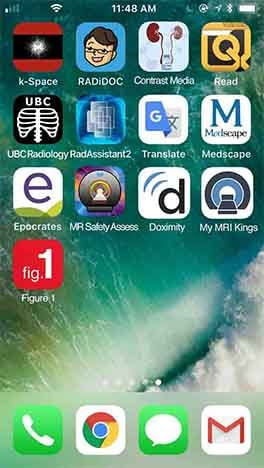Look for increased use of radiology apps in 2018.

There are many old friends and a few new capabilities in the list of best radiology apps for 2018. In both iOS (with over 2.2 million apps) and Android (more than 2.8 million apps) some of the old standbys are still among the most popular in use today.
A picture of iPhone home screen with radiology apps downloaded.
Find all of these radiology apps in the App Store and Google Play.
Apps for radiology students, technologists, and educators
Many apps are designed to help teach radiology. One of the coolest of these, at least from a graphics standpoint, is k-space Odyssey, an app that helps users understand some of the concepts and variations in MRI. Interactive sliders let you apply high- and low-pass filters, a sparsity filter, and motion artifacts. You can also vary Voxel size, and apply other effects not only on supplied images, but also on your own imported images. It’s educational, easy, and fun to use.
The UBC radiology app is based on the radiology undergraduate curriculum at the University of British Columbia (UBC). This app will serve as an introduction to radiology as well as a refresher for those studying for exams. It will challenge you to decide on the appropriate modality to choose—CT, MRI, radiography, or ultrasound—or no imaging at all. In addition, it offers insight into approaches, pre-clinical insight, and examples with imaging for study and analysis.
Apps for referrings and attendings to facilitate consultation
Eastern Virginia Medical School developed an app to assist in “Streamlining the Radiology Consultation Service in the Digital Era” (1). This app for both Android and Apple devices was made available to all residents and attendings and included assistance designed to help techs and clinicians with appropriate ordering of imaging studies, contrast administration, scheduling and schedule change notifications, and postings of different department lectures. Physicians who used the app reported an extremely positive experience. Radiology Business reports, “Now that this prototype app has been successful, a more sophisticated platform is being researched to better suit our department’s needs and to continue to offer value through our consultation service.”
Apps for safety
A useful safety app is Dr. Emanuel Kanal’s MR Safety Implant Risk Assessment. This app complements The Kanal Method safety training. Its checklist approach will be a refresher to those who have completed a course, and helpful to those who have not pursued formal MR safety certification. It is designed for those scanning patients with implants or devices. It was also listed as one of the Top Apps in 2017.
To help radiologists and technologists minimize renal Nephrogenic Systemic Fibrosis (NSF) and Contrast-Induced Neuropathy, the Contrast Media: NSF vs. CIN app is useful to assess risks and benefits in choosing the safest contrast agent for renal impaired patients. This app was a semifinalist in Aunt Minnie’s Best Radiology Mobile App 2016, and one of Diagnostic Imaging’s Top Apps for Radiology 2017.

Apps to help keep up with radiology literature
According to an article published by the Journal of Digital Imaging (2) in cooperation with Society for Imaging Informatics in Medicine (SIIM), there are a total of 20 radiology journals with a dedicated app for subscriber viewing. Because these journals with apps had a “higher mean impact factor when compared with those journals that did not have a dedicated app”, JDI concluded that “radiology journals and their publishers should be encouraged to design and maintain mobile apps for their readers.”
A useful app for radiologists and other readers of diagnostic imaging medical journals is Read by QxMD. This app lets you search, browse, and access full text through your subscription (or university subscription) and provides a way to share articles over email, Twitter, and Facebook.
Another useful app to help radiologists and technologists keep up with the growing radiological literature is RadAssistant2. It offers search capabilities across dozens of medical publications indexed with photo clips for easy reference.
A picture of the Rad App open
The EVMS Rad App provides simple access to protocols, schedules, and contact information for residents and attendings to facilitate consultation.
Apps for clinicians
Two apps that are as useful to clinicians on a daily basis today as they were in 2015 are Epocrates for drug information and Medscape to stay current with medical news. But there are other notable radiology apps that are growing in usage and acceptance. Over half a million clinicians communicate with other medical professionals using apps like Doximity, and over a million medical professionals share medical images and request feedback from other clinicians on a puzzling case using the app Figure 1. These apps encourage image sharing and support collaboration and community among clinicians.
Apps for clinicians to use with patients
RadiDoc is an app that helps to put radiation dose into perspective. Based on information provided by the patient, it offers an average dose number for many common studies and compares that dose with activities likely to be familiar. For example, a chest X-ray with a dose of 0.1mSv is identified as a low dose equivalent to “0.4 months of natural background radiation from sources like the sun and earth.”
Virtual Reality (VR) apps are also a current trend. They allow a technologist or radiologist to demystify a scary experience by showing it in a realistic 360° view. King’s College Hospital in London created the My MRI at King’s app “for children and their parents, to help ease the fear of attending an MRI scan.”
Finally, no article on apps in 2018 would be complete without mentioning the Google Translate app, which can help clinicians overcome language barriers with 2-way instant speech translation in 32 languages between patients and clinicians.
Comentarios
Publicar un comentario